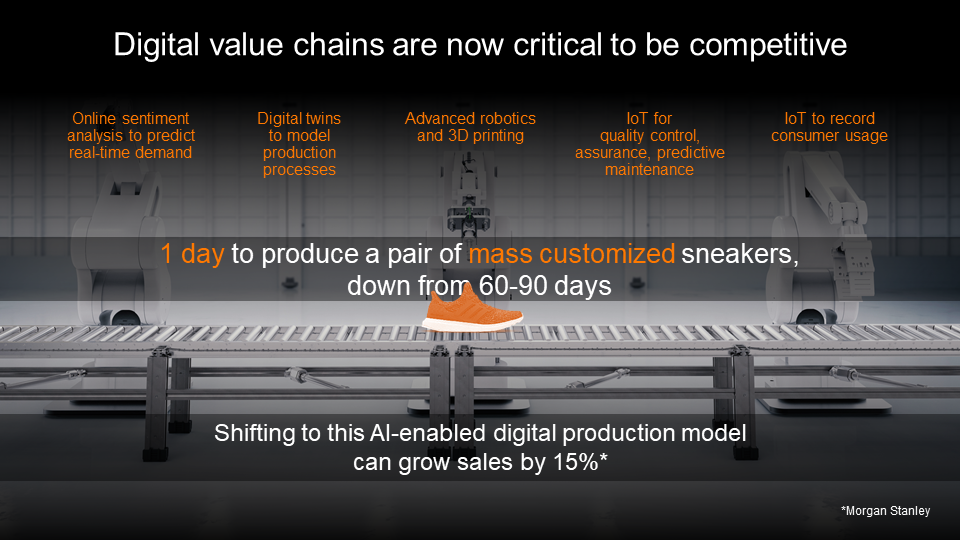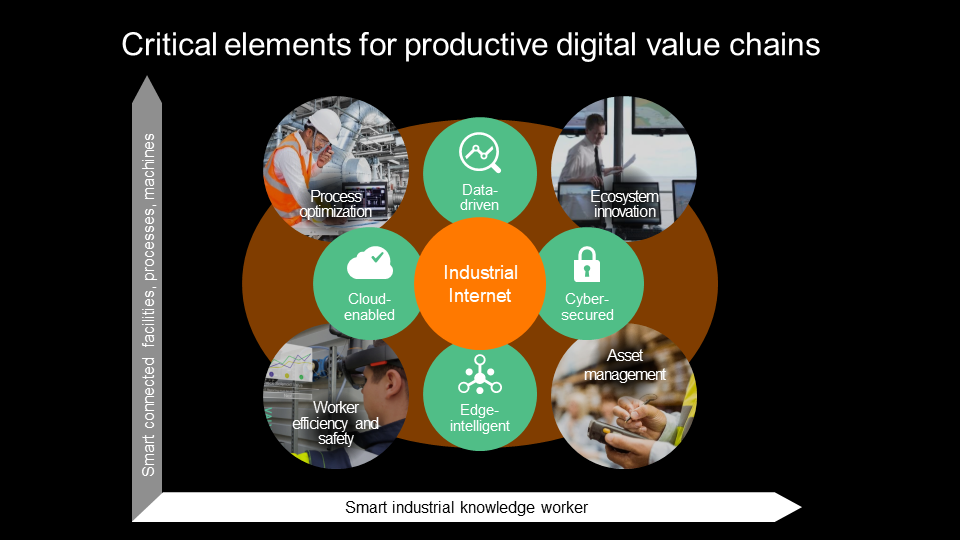Today, 70% of trade involves global or multinational value chains, according to the Organisation for Economic Co-operation and Development (OECD). Parts of a product are often made in low-cost regions, like Vietnam, assembled in Taiwan or China and delivered to U.S. or European online marketplaces. Each international stop in the chain adds incremental value to a product until it's ready to be sold.
But there are signs that times are changing. The OECD calculates global trade growth slowed down to 2.1% in 2019, compared to 5.5% in 2017. This reflects a massive structural change to the world economy. Soaring wages in low-cost regions and concerns about corporate social responsibility have changed the market dynamics. Already China is re-balancing away from a reliance on exports and manufacturing towards consumption and services. Some 250 million Chinese over the past 10 years have entered the middle class and are increasingly looking to buy experiences rather than products.
At the same time, e-commerce has convinced customers that they can have an endless choice of customized goods at great prices, delivered almost instantly. This presents a major challenge to today’s inflexible supply chains. It has created the need for digitized supply chains that can provide products faster, better and at lower cost.
Factories need to be able to accelerate NPI (new product introductions) and accommodate “swing production,” moving rapidly between producing different products on a daily basis. Digital twins make it possible to rapidly model advanced new robotics systems on high-speed production lines and monitor them in real time. Meanwhile, computer vision, augmented reality (AR) and AI are now being used to inspect and capture quality defects earlier in the production process.

The need for digitization is urgent
“There are many signs that physical value chains have reached the limits of automation and now need to be complemented by digital innovation,” says Helmut Reisinger, Chief Executive of Orange Business. “For example, we need to digitize asset management – the tracking of raw materials, parts, assembled goods, tools and vehicles – and the management of machinery with remote and predictive maintenance through IoT.”
Reisinger believes it’s vital to empower the new “smart, industrial knowledge worker” with data insights – delivered at key decision-making moments – via IoT, AR and as digital work instructions on ruggedized tablets. In a world driven by data, workers need input from AI to choose the right actions to take. Human-and-machine synchronization is key.
“What I see from talking to our multinational clients is that digitization of the operational world is a crucial factor of competitiveness. There is a rendezvous between operational technology and IT; digitizing and connecting the unconnected is vital for every enterprises’ future productivity and competitiveness,” says Reisinger.
Take the example of Heathrow airport, which is nearly at full capacity today. The airport is capped at 480,000 annual “movements” (the industry jargon for arrivals or departures) and currently operates at about 475,000 each year. Every day, 213,000 passengers land or depart, with a plane taking off or landing every 45 seconds, which is about 1,300 planes a day.
In this complex environment, planes arrive early or late, depending on whether there has been a tail or head wind. There are gates with connecting walkways or moveable stairs and buses. There are hundreds of thousands of passengers and contract workers handling baggage, ground transport and airline catering. To make sense of it all, people need to be connected to people, but also to objects, infrastructure, business workflows and business ecosystem partners. This is how you can enable AI and data-driven decision making and improve human-and-machine synchronization.
This approach works for just about any sector, as Reisinger explains: “We’ve been approached by a major global metals manufacturer, for example, whose plants are at full capacity. In this case, we’re looking at autonomous guided vehicles as a means of achieving new operating efficiencies. Meanwhile, we’ve successfully provided an IoT asset-tracking solution to a major oil and gas firm to enable it to precisely identify the location of tools and vehicles across its large campus in the U.S.”
OT and IT convergence
Asset-intensive enterprises need to transform from disconnected or minimally integrated IT and operational technology environments into integrated businesses, according to Gartner.
Industry, however, isn’t always finding the journey easy. Only 30% of Industry 4.0 programs have been scaled, according to a recent survey by McKinsey. Seventy percent are stuck at the proof-of-concept stage. Industry 4.0 is a new era in the industrial revolution that centers on IoT, real-time data, machine learning, automation and the interconnectivity of business processes. It’s essential that IT and operational technology (OT) converge securely to enable Industry 4.0 with data flows that enhance efficiencies and productivity.
A high level of cooperation is necessary between IT and OT teams. “This will require a hybrid of traditional IT and OT skills and the development of new intellectual property, while experience external to the company will be tapped into to assist with cross-topic education,” says Kristian Steenstrup, a distinguished analyst at Gartner.
IT/OT convergence integrates operational technologies – such as Supervisory Control and Data Acquisition (SCADA), meters and sensors – which run in real time or near real time with modern IT systems. IT and OT teams have traditionally worked separately with separate networks and budgets. The increasing complexity in OT, together with greater processing demands on IT, however, is blurring the lines and driving a merger between the two and creating the need for more comprehensive security.
The business case for IT/OT convergence includes better global visibility of production, as well as increased productivity, reliability and agility. Yet much of the OT world is still to be digitized. In France, for example, the government industrial body estimates that only 30% of OT is digitized.
Connecting to the digital world
Reisinger believes there are five key elements that are essential to connect the OT space to the hyperconnected digital world. OT/IT convergence will be driven by the creation of a new industrial Internet that uses time sensitive networking (TSN) protocols and 5G to enable open data sharing. This overcomes the challenge of the proprietary nature of existing OT equipment and networks, which hinders data sharing with broader IT systems. This new industrial Internet will be hyper connected, data driven, multi-cloud enabled, edge smart and will have end-to-end cybersecurity.

Many industrial enterprises are brownfield sites. In a factory, equipment often has a 30-year replacement cycle, while in the nuclear industry, machinery needs to work for as long as 50 years before it is replaced. This creates the need to retrieve data from previously unconnected systems in a secure way and ensure it’s in an open format that can be analyzed by IT systems. For example, Orange has worked with a major concrete manufacturer to implement brownfield data translation gateways to enable production-chain data to be analyzed in IT systems for better end-to-end business planning.
Orange works closely with OT teams to directly address their challenges. For example, one company operating in the specialty sector needs to switch between producing different chemicals on a daily basis. The biggest challenge was human error in mixing formulas. Orange tagged the components in the warehouse, put weighing scales on the fork lifts and provided workers with connected ruggedized devices on which to view chemical recipes. The result has been a rise in factory output and productivity.
IT/OT convergence: powering future innovation
According to Reisinger, “The era of the Internet of Enterprises is about sharing know-how. In the industrial space, it’s an ecosystem play where different processes need to work together.”
In this new world, the company co-innovates with its customers, bringing together its own expertise in advanced data management and industry with the specialist capabilities of factory automation and engineering partners to create new business value. Orange Business is able to draw on its many different capabilities and strengths as a network-native digital services company.
For more information, watch our video on creating new business value with OT and IT convergence.
To view this video content, you must accept YouTube cookies.
These cookies make it possible to share or react directly on the social networks to which you are connected or to integrate content initially posted on these social networks. They also allow social networks to use your visits to our sites and applications for personalization and targeting advertising.